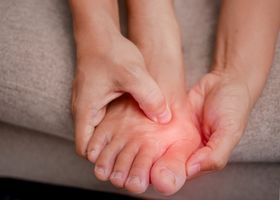Ankle Pain Symptom Checker: Why Your Ankle Hurts
Updated December 17, 2024

Ankle pain has many potential causes due to the complexity of the joint and the amount of stress it is exposed to daily. Ankle pain can therefore stem from any of the structures that make up the ankle joint and muscles of the lower leg. When identifying the cause of your ankle pain, it is essential to understand how the injury occurred—if any—and whether the pain arose suddenly or has festered for a longer period.
This will guide you in identifying the cause of your ankle pain and the best treatment options available.
Symptoms That Accompany Ankle Pain
- Swelling around the ankle
- Painful moving joint
- Bruising
- Burning pain sensation
- Inability to bear weight
- Redness and inflammation
- Stiffness in the ankle
- Feelings of instability
Should the onset of pain be without a memorable incident to the ankle, as mentioned above, conditions such as osteoarthritis, rheumatoid arthritis, gout, and more should be considered.
Common Causes of Ankle Pain
Osteoarthritis
Characterized by pain and/or stiffness occurring in the joint due to the breakdown of the cartilage causing the bones to rub against each other, leading to the development of pain over time. Repeated ankle sprains or fractures can increase the chances of developing arthritis in the affected joint in the future. It is also more common in persons over the age of 65.
Other symptoms include:
- Pain and/or stiffness in affected joint
- Pain and/or stiffness at night
- Swelling around the joint
- Reduced ability to move or walk
Rheumatoid Arthritis
Rheumatoid arthritis (RA) is an autoimmune disease that leads to inflammation and pain around the body. The ongoing inflammation caused by rheumatoid arthritis leads to bone and cartilage erosion and joint deformity, usually in multiple joints throughout the body. In severe cases, RA can affect your internal organs.
Gout
Gout falls under the category of arthritis. Although a less common cause of ankle pain, gout does cause pain and inflammation through the accumulation of uric acid deposits in the joints as the kidneys cannot clear the waste products from the blood. Medical advice should be sought immediately if you have any of the following symptoms and suspect you have gout:
- Severe pain
- Swelling
- Feeling of warmth and stiffness in one or more joints
- Painful lumps
- Sudden flare-up of pain
Achilles Tendon Injuries
Characterized by pain felt over the back side of your leg in the area of the lower calf muscle when attempting to push your foot downwards or stand on your toes. Should you hear a loud “snap” after you suffer an injury, seek advice from a medical practitioner immediately, as you may have ruptured a tendon.
Ankle Sprains
Ankle sprains are characterized by a ligament overstretching or rupturing. An inability to flex the foot down and twist inwards with noticeable pain on the front and outside of the ankle usually indicates ligament involvement. Ankle sprains are a common cause of ankle pain among people of all ages and are a large contributor to osteoarthritis experienced by persons over 65.
Rest, ice, compress, and elevate (RICE) the injured ankle to reduce the swelling and pain. Should the pain continue for more than four days with noticeable swelling/bruising around the ankle and an inability to bear weight, seek medical advice.
Ankle Fractures
The first step in identifying if the cause of your pain is related to a fracture is to discern if there has been an incident involving trauma to the ankle or lower leg, such as a dramatic fall or a severe twisting injury. Pain experienced upon touch or around the bony prominences on the inside and/or the outside of the ankles requires further medical attention and an X-ray.
Infection
Osteomyelitis is a bone infection caused by bacteria or fungi and characterized by pain and inflammation in the affected bone. Without treatment, swelling from the bone infection can put pressure on and damage surrounding structures.
Cellulitis is a skin infection that is painful, red, and swollen. If left untreated, the infection can spread. Medical treatment is required immediately to avoid any complications from infections.
Signs of infection include:
- Fever
- Lethargy
- Drainage of pus
- Loss of appetite
- Limited and painful movement
Overuse injuries
Overuse injuries occurring to the ankle and foot are often overlooked by many in identifying the cause of ankle pain. A change of footwear, an increase in distance covered during a running activity in a week, and the use of shoes with a prominent heel can contribute drastically to ankle and foot pain.
When to See a Doctor for Ankle Pain
Seek medical advice should you experience any of the following symptoms:
- Pain that is too severe to perform daily activities
- Any obvious displacement of bone in the lower leg or foot
- Pain over the inner and outer ankle bone (medial and lateral malleolus)
- Inability to bear weight effectively on the ankle several days after the injury
- Severe bruising around the ankle
Can Ankle Pain Be Relieved?
Ankle pain can be relieved using orthotics as the first step in the corrective process to aid you in walking and running pain-free again. Custom orthotics from Upstep.com are tailored to your foot specifically to increase cushioning by providing arch support and redistributing the weight evenly, preventing pressure points from developing.
Orthotics have been proven to reduce ankle, knee, and back pain by maintaining alignment from the base upwards. Compensatory walking for painful feet and ankles can be avoided, preventing potential pain from arising in other joints or areas.
Whether you’re an athlete or someone that works on their feet for many hours, you’ll find benefit from using custom orthotics in your shoes.








